Andy Lloyd's Dark Star Blog

Blog 73 (April 2019)
Planet X Doomsday
Despite decades of
disappointment, the prophets of Planet X Doomsday
continue to peddle their internet wares. Much of it
has been built upon my own writings about the Dark
Star:
"This
object, which could be a red or brown dwarf star
heading our way, several times the mass of Jupiter,
and which is called by some Nibiru or Planet X, may
be approaching earth in or around 2012. This dark
star could be lurking near our solar system, forcing
comets in our way. Have we not seen a major increase
of meteors lightening up the night sky lately? Can
there be something to this apocalypse conspiracy,
doomsday 2012 The End of the World, Tribulation End
Times Prophecy, Nibiru and Planet X 2012
Predictions?" (1)
I've always argued that such an
object must be located very far away, out amongst
the comets. But it has not stopped many
prophets of doom from picking up what they want to
read and relaying it in a fundamentally more
disturbing package. They're a lot more
successful at sending out a message than I am.
Their stories are more sensationalist, more
attention-grabbing in our age of Fake News, more
exciting to read. They're also increasingly
wrapped up in religious messages, and associated
with some pretty zealous ideology.
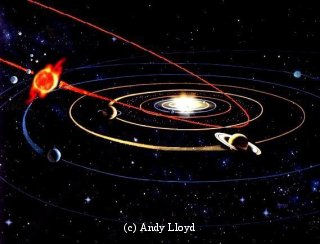
Naturally enough, the proposed
date for the Return of Nibiru is always a couple of
years away, like a planetary carrot at the end of a
stick. For those doomsday-mongers who are
dissatisfied with their colleagues' arguments that,
yes, it did actually turn up around 2012 - just no
one noticed, the opportunities are aplenty to re-jig
the timeline to suit their current campaign
strategy. Here's the latest - written by an
unknown author but likely the Swede Ville Hietanen
(who is the only contact listed for a network of
websites knocking this stuff out in impressive
fashion):
"Nibiru
is believed to reach the zenith of its orbit around
our Sun in 2019 and then will return in Earth's
direction before finally heading away in 2022 or
2023 (the time-line may of course be wrong); Earth
disturbances will continue through this period,
being strongest once a year when Nibiru approach
closer to Earth in its orbit around the Sun.
"Nibiru
will cause even greater earthquakes, more volcanic
eruptions, rising sea levels, high winds, dust
storms and torrential rains causing great floods.
There will be a polar wobbling, a magnetic pole
reversal and a pole shift that will place the North
and South Poles on what is now the Equator. The pole
shift will occur over a period of several months. As
Nibiru passes, its tail will rain asteroids onto the
Earth and will heat and alter Earth's atmosphere.
Dust in the air will completely blot out the Sun for
six months, possibly leading to an ice age."
(2)
The timeline may indeed be wrong.
But people take this stuff seriously enough, and
it's presented in a convincing way, with a plethora
of scientific studies about our changing solar
system to back it up. Calculations are made by
some Planet X enthusiasts, using perfectly good
physics (like Kepler's laws of motion), to show how
such an object might sweep majestically around its
perihelion trajectory (3). When they do, they
see that such a celestial motion takes years.
Years. If it was faster, then the motion of
the Dark Star/Planet X/Nibiru would be hyperbolic -
its speed would allow it to escape from the Sun's
gravitational field and head out into the Cosmos.
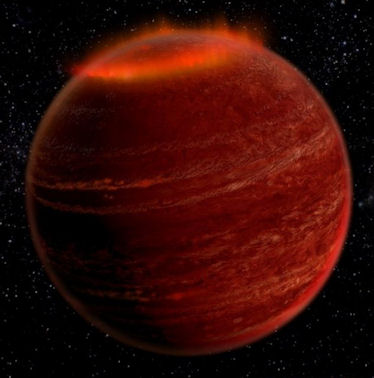
So, if a planetary interloper was
destined to pummel Earth with meteorites, or disrupt
its magnetic fields, in the next few years, then it
would currently be amongst the planets already. At a
distance just beyond the orbit of say, Saturn,
Planet X would be a planet that we could easily see
with the naked eye. If it's a gas giant-sized
object at that distance of, say Mars, then it would
be considerably brighter than Jupiter or Venus at
their brightest (and they're the brightest objects
in the sky after the Moon).
To get around this uncomfortable
truth, Planet X Doomsday prophets often argue that
the object is currently located behind the Sun,
perhaps edging out from behind it to be 'seen'
fleetingly at sunset or sunrise. The fact is
that Nibiru can't be hiding behind the Sun for years
as it traverses into the solar system - the Earth's
own motion around the Sun means that Planet X would
spend most of the year out in the open, out in the
night sky for all to see. Because it's not been
there (self-evident), then by inductive reasoning
this narrative about Planet X at only a few AU is
incorrect - even though such a proposal may been
presented with some good theoretical underpinnings.
In other words, planet X is not
about to cause Doomsday. Yay. There's no
cover-up by governments about this. If the modern dark
Prophecies were true, it would be plain for all to
see: Planet X would already be one of the
planets in our night sky. But, it isn't. In
the 20 years that I've been researching the Planet X
topic, I've seen the subject of Nibiru morph from a
vaguely intellectual debate about the interpretation
of ancient Mesopotamian texts into an internet-based
Doomsday Cult centred upon a fairly extreme
interpretation of Christian 'End Times'.
Stating this openly draws derision from social media
trolls:
"Doomsday cult... you're a
tool. Least when the lights go off your books will come in handy to put in
bonfires". (4)
Naturally, comments like this are
accompanied by their authors quickly blocking me
from replying, and therefore preventing me debating
the topic with them. No real exchange of views seems
possible these days - just the playground politics
of who abusively shouts the loudest.
All of this on-going sensationalist hype about Nibiru
Doomsday that doesn't mean there
isn't a Planet X body out there, somewhere. I've
collated all the latest evidence for this in my new
book
'Darker Stars' (5). However, this planet is so far away that
it poses no direct threat to us. Its primary
effects at this time are with objects in the outer
solar system, beyond the Kuiper belt. That's
not sexy news. It's not scary. But it's
quite likely to be true. It's one of the great
ironies of this whole topic.
Written by Andy Lloyd,
26th April
2019
References:
1)
Ville Hietanen (?) "Doomsday Predictions
Happening Right Now Proven by Scientists!" Date unknown
doomsdaytube.com/
2) Ville Hietanen (?) "Nibiru Planet
X, Ison Nibiru, Nibiru Timeline, Nibiru Update" Date
unknown with thanks to
Peter
nibiruplanetx.info/
3) Correspondence from Peter
Brown, 17 April 2019
4) Correspondence from Secret
SoSHHiety @sandboxtactics, 21 April 2019
5) Andy Lloyd "Darker Stars" Timeless Voyager Press, 2019
 Darker Stars: New Evidence
Darker Stars: New Evidence
Oil, Gas and Groundwater on Mars
The latest science reports about Mars make for intriguing reading.
A century ago, the concept of 'canals' on Mars was all the rage - with
Victorian era scientists and science fiction writers alike wondering
about life on the red planet. The Viking landers in the mid-70s
sent back the now familiar images of the Martian surface: our
neighbouring planet is covered in arid, stony deserts. But there
was still a hint of hope of life in this desolate expanse - one of the
experiments conducted by Viking - the 'Labeled Release' (LR) experiment
- came up positive for metabolic processes within the Martian soil (1).
The Viking LR experiment was one of a series, however, whose general
negativity negated this one result. Some scientists argued that the
result should not have been ignored (2).
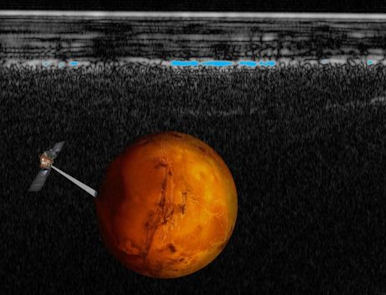
Over time, landers became rovers, and the experiments
continued. One of the surprise detections on Mars has been the
occasional, but very clear, detection of atmospheric methane. This
gas is often associated with biological activity (biogenic methane), and
may indicate the presence of microscopic organisms on, or below, the
surface of Mars. Alternatively, it may relate to geophysical
processes - natural processes occurring along tectonic fractures
involving heat, pressure and water. Or thermogenic methane may
have been produced by the breakdown of buried microorganisms (usually
associated with sub-surface gas and oil reserves on Earth). The
detection of methane by the Curiosity rover in 2013 caused many eyebrows
to raise within the planetary science community.
The methane
emission was certainly real - and has been confirmed by instruments
on-board the Mars Express Orbiter (3). However, even now, 6 years on, it
is not clear what the origin of the methane was. Strangely,
though, the overall levels of methane in the Martian atmosphere have
been found to be very low:
"The ExoMars Trace Gas
Orbiter’s first analysis of the Martian atmosphere at various points
around the globe finds an upper limit of methane 10–100 times less than
all previous reported detections." (3)
This still corresponds to 500 tonnes emitted over the
300 year lifespan that methane is thought to have in the atmosphere.
Scientists are now trying to figure out what is happening to the plumes
of emitted methane that had been previously detected - is there a
mechanism close to the surface that is removing methane? Mars is
particularly prone to short wavelength UV radiation, which may be
driving speedy chemical reactions with the methane. In other words, I
wonder whether methane is extracted from the atmosphere by natural
processes much quicker than it is on Earth. There are mysteries about
the origins of the plumes of methane detected, as well as the overall
absence of the gas in the atmosphere.
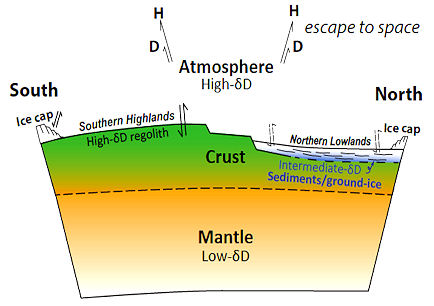
Recent arguments
have been offered around the trapping of methane in permafrost, which is
periodically released by tectonic activity breaking the ice (4). Could this Martian methane be associated with pockets
of underground natural gas or oil? There are good reasons to
consider this as a possibility. In 2000, NASA Ames research
scientist John McGowan argued that the decomposition of ancient oceanic
life on early life-friendly Mars could have built up the kinds of oil
and gas reserves that are so familiar to us on Earth:
"If Mars possessed an
Earth-like biosphere at one time in the past, Mars may contain
sub-surface deposits of oil and natural gas which would constitute
evidence of past life. Life might still exist in these deposits."
(5)
Evidence for ancient lakes and oceans were suggestive
of such a possibility 20 years ago. At that point, there was also
emerging evidence of movements of ground water across the Martian
surface, as well as an understanding of the changing Martian climate
over long time periods, suggesting that Mars was warmer and wetter as
early as 300 million years ago (6). Since then, there has been a
growing recognition that water may have moved across the Martian surface
in relatively recent times. It has been shown that substantial
rivers flowed intermittently across the surface of Mars until perhaps
just 1 billion years ago (7), in contrast to scientific orthodoxy about
the much earlier 'death' of Mars. The run-off of water feeding these
large rivers must have been from precipitation - Martian rain.
Yet, the current thin atmosphere of the red planet is incapable of
supporting this kind of weather. This implies an evolving
atmosphere over time, in keeping with the highly changeable nature of
Mars' orbit. Drawing upon all the most recent discoveries, I argue
for this in the chapter entitled 'Meandering Mars' in my new book
'Darker Stars' (8).
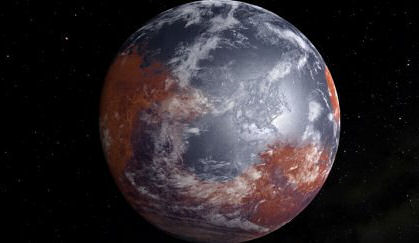
Image Credit: NASA Goddard Space Flight Center
There is also evidence of a much broader and -
importantly - active body of deep groundwater across Mars.
Pressurised groundwater seems to be seeping up through breaks in the
frozen surface, and emerging as ground water springs (9). So, it's
not just methane that's bubbling up to the surface of the red planet.
The impossible presence of 'recent' water across the surface of Mars
demonstrates that the planet is keeping secrets from us below its
surface.
These secrets may include precious 'black gold'.
The timescale for the warmer and wetter Martian climate is in keeping
with that of the deposition of organic materials on Earth to form oil
and gas. McGowan's 2000 paper sets out how Martian oil and gas deposits
could be discovered through the detection of natural gas, primarily
methane, by rovers, detectors aloft upon prospecting balloons, and by
on-board equipment on future orbiters (5). His scientific
predictions seem to have come true. He notes that surface seepage
of natural gas/methane is likely to preferentially find
"large deposits near the surface that will be
the easiest to study" (5). And, presumably, access.
After all, any future manned colony on Mars could benefit tremendously
from a readily accessible oil and gas reserve: Fuel, refining,
manufacturing.
I'd go further though. We don't know what lies
below the surface of Mars, but the hints we're now getting indicate
incredible potential for untapped resources. The orbit of Mars
fluctuates greatly, and it seems fairly obvious to me that there have
been distinct ages in Martian history when its position with respect to
the Sun enabled very different atmospheric conditions to proliferate.
If this is the case, then it may go some way towards
explaining another Martian mystery - the anomalous relative youth of
many Martian meteorites that have been found on Earth. It has been
long argued by some scientists that microfossils of Martian bacteria
have been discovered in meteorites that were once chipped off the
Martian surface, before making their way to our planet. Recently,
another candidate for fossilised Martian life has been presented in the
scientific press; this one thought to be contained within the
ALH-77005 meteorite (10).
The arguments presented for and against determining
whether ancient bacterial life is recorded in meteorites quickly become
technical, often centering around the potential for contamination on
Earth, or whether these tiny structures are geophysical rather than
biological. But what stands out to me in these debates is how
young the meteorites are: ALH-77005 is estimated to be
just 175 million years old. Mars is not thought
to be a particularly active planet, lacking tectonics plates or recent
volcanic activity, and its cratered surface is therefore thought to be
ancient. Yet, three-quarters of Martian meteorites (the
Shergottites) are less than 180 million years old (11). That means
they were chipped off the planet not so long ago, in geological time.
This begs the question - by comparison, why does the cratering across
the Martian surface appear so ancient? This question has become
known as the 'Shergottite Age Paradox' (12). Perhaps most of the
known Martian meteorites were ejected from a single, relatively recent
impact event? Or perhaps the age of the meteorites indicate that Mars
still has secrets to share with us about its geophysical history. If its
surface undergoes periodic makeovers due to extreme climate change then
those processes (weathering/fluctuating glaciation) may have hidden more
recent craters in affected areas (which may be extensive).
Let's say that below the Martian surface there are
significant deposits of volatiles, awaiting renewed climate change as
Mars' orbit fluctuates. Release the volatile ices into the atmosphere as gas,
particularly greenhouse gases like carbon dioxide and water, and conditions would
fundamentally change. Perhaps there is a very deep and massive collection
of atmospheric gases frozen below the Martian surface, pooled into
extremely deep lakes, even oceans, waiting for the warm times to return.
The reason for suggesting this is the evidence of flowing rivers - which
would be quite impossible without a supportive atmosphere to create a
significant water cycle. There
are so many other quirky features across the Martian surface, too, with ultra-deep
chasms, and ultra-high calderas. Perhaps these hint at a profound
geophysical asymmetry which is hidden by a relatively even distribution
of frozen sub-surface groundwater/dry ice. I'm suggesting that the
currently understood inventory of carbon dioxide and water on Mars (12)
may have been massively underestimated, based as it is upon what can be
seen upon the surface and within its thin atmosphere.
Below the Martian surface lies the missing atmosphere - not driven off,
but just frozen and buried... waiting.
So, if that turns out to be the case, the potential
for terraforming Mars is, frankly, incredible. We wouldn't need to
rely upon inventing new tech to terraform the red planet, or bringing
water and carbon dioxide to the planet from comets (13). Instead,
we could release and harness the atmosphere that Mars is keeping secret
from us below-decks.
Written by Andy Lloyd,
3rd- 12th April
2019
References:
1)
Lisa Zyga "Did 40-year-old Viking
experiment discover life on Mars?" 21 October 2016
phys.org news
2) Gilbert Levin and Patricia Straat. "The Case for
Extant Life on Mars and Its Possible Detection by the Viking Labeled
Release Experiment," Astrobiology, October 2016, 16(10): pp798-810
3) ESA "First results from the ExoMars Trace Gas Orbiter"
10th April 2019
esa.int article
4) BBC News "Mars methane surge spotted from space" 2
April 2019
bbc.co.uk news
5) John McGowan "Oil and natural gas on Mars"
Proc. SPIE
Vol. 4137, p. 63-74, Instruments, Methods, and Missions for Astrobiology
III, 12/2000
http://jmcgowan.com/oil_spie.pdf
6) Jeffrey Kargel & Robert Strom "Global Climatic Change
on Mars" Scientific American, 1996, 275(5): pp. 80-88
7) Mike Wall "Mars Had Big Rivers for Billions of
Years" 27 March 2019
space.com article
8) Andy Lloyd "Darker Stars" Timeless Voyager
Press, 2019
 Darker Stars: New Evidence
Darker Stars: New Evidence
9) Amy Blumenthal "USC researchers find new evidence of
deep groundwater on Mars" 28 March 2019
usc.edu news
10) Paul Scott Anderson "New evidence for life in a
Martian meteorite?" 7 April 2019
earthsky.org article
11) L. Nyquist et al. "Ages and geologic histories
of Martian meteorites", Space Science Reviews, 2001, 96: 105–164.
12) L. Nyquist, L. Borg C.-Y. Shih "The Shergottite age
paradox and the relative probabilities for Martian meteorites of
differing ages" JGR Planets, 103(E13): 31445-31455
13) Bruce Jakosky & Christopher Edwards "Inventory of CO2
available for terraforming Mars", Nature Astronomy, 2018, 2: pp634–639
14) Bill Steigerwald and Nancy Jones "Mars
Terraforming Not Possible Using Present-Day Technology" 30 July 2018
NASA article
Hubble to
Scope the Kuiper Belt
A good proportion of the Kuiper belt consist of binary objects, and this
has led to the idea that planetesimals initially form as pairs, rather
than as solitary objects. The recent flyby of Ultima Thule by the
new Horizons probe has served to intensify this debate, as this object
was found to be a fascinating example of a bilobate object (1).
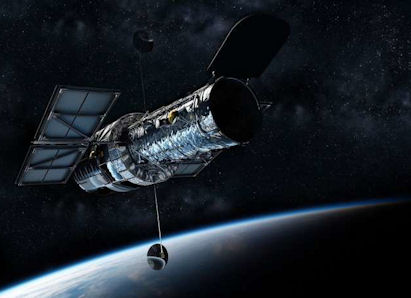
To test
the binary hypothesis, as well as to learn more about the KBO
populations, the Hubble Space Telescope will undertake a lengthy project
to scope over 200 objects, measuring their binary/solitary properties,
and their colour. This is the reason why these properties may be
connected:
"Recent models of small body
formation suggest that binaries are leftovers of the very earliest times
of our solar system, when pairs of bodies could form directly from
collapsing swarms of small-scale “pebbles.” Competing theories of
planetesimal formation predict different size and color distributions
for binary and solitary KBOs. If objects first formed through an
accretion process and were merged into binaries later, scientists expect
the objects in binary systems to have dissimilar colors and to have a
different size distribution than solitary objects. However, if
planetesimals formed through a rapid collapse process that produced some
solitary objects and some binary systems from the start, scientists
would expect objects in binary systems to have a similar surface color
and a size distribution similar to that of solitary objects."
(2)
NASA has awarded this programme, known as the Solar System
Origins Legacy Survey (SSOLS), to the Southwest Institute (3).
It builds upon the previous work of OSSOS and CFEPS, this time targeting
previously identified candidate KBOs from these large surveys.
Written by Andy Lloyd,
3rd
April
2019
References:
1) Andy
Lloyd "Ultima Thule : A Tumbling Red Snowman" 2-7 January 2019
https://www.andylloyd.org/darkstarblog70.htm
2)
Southwest Research Institute "SwRI to conduct largest ever Hubble survey
of the Kuiper belt", 2 April 2019
swri.org press-release
3) Alex Parker
"Testing Origin Theories" SSOLS
https://www.ssols.space/menu
The Early Birth
of Planets and Life
How planets form remains something of a mystery - or, at
least, a complicated jigsaw with some of the pieces
still missing. Planet formation is usually
associated with a rotating protoplanetary disk around a
young star, where dust and gas from the pre-solar nebula
collapses down into growing (or accreting) chunks or
matter, known as planetesimals. Astronomers have been
able to observe these disks separate into concentric
rings around very young stars, probably indicating the
presence of planetesimals within the gaps which are
collecting up the dusty, gaseous materials (1). It
has become clear that this is often not a sedate
process, but can instead be remarkably quick (2),
occurring over a few million years, or even less.
The processes that take place may be complex, with the
'ring structure' of the disk shaped by resonance
patterns. This means that not all the gaps may
contain planets - some may arise as a result of
gravitational effects associated with planets emerging
elsewhere within the disk (3).
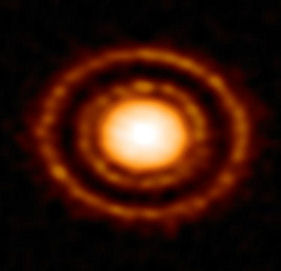
Image Credit:
ALMA (ESO/NAOJ/NRAO)/ D. Fedele et al.
In the case of the protoplanetary disk AS 209, for
instance, a planet appears to be quickly forming at a
very significant distance from the young parent Sun-like
star (which is less than a million years old):
"The outer
gap is deep, wide, and largely a dust-free zone, leading
astronomers to believe that a giant planet almost the
mass of Saturn is orbiting here — around 800
light-minutes from the central star, and more than three
times the distance between Neptune and the Sun!"
(1)
If you were to place this this Saturn-sized planet into
our own solar system, it would be located well beyond
the Kuiper belt, and would be a massive Planet X-type
object. This indicates that substantial planets can form
at these distances from Sun-like stars.
Astrophysicists think that planets are able to migrate
to new locations within their systems, as a result in
changes of gravitational attraction and gas pressures
resulting from the collapsing protoplanetary disks.
But they can't be sure that this exoplanet forming at
the periphery of AS 209 will get dragged back into the
planetary system from its distant location.
Perhaps, then remotely located planets like this are
commonplace - after all, the further they are away from
their stars, the more difficult these objects are to
detect. So, we cannot know one way or another.
At the opposite end of the planetary zone spectrum, as
well as the lifespan of stars, a planetesimal has been
discovered orbiting very close to a collapsed star,
specifically the white dwarf
known as SDSS J122859.93+104032.9.
The tiny planetesimal orbits the white dwarf in just
over two hours. This 600km planetesimal, which is
likely to be an iron-rich rocky remnant of a destroyed
planet (during the star's red giant phase), is immersed
within a dusty disk of its own, thought to be emanating
from what non-rocky remains are left upon this shattered
world. Dusty disks around white dwarfs are known,
but remnant planets are rare. For me, this begs
the question whether these dusty disks might re-accrete
planets? Could planets re-form, building up again
from the iron-rich planetesimal cores left over
following the collapse of the red giant? This
would be a new example of planetary recycling, offering
the opportunity for a new category of exoplanets 'born'
around dead stars.
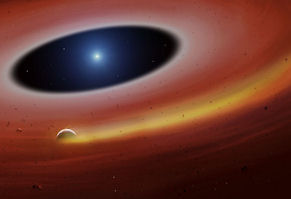
Image Credit: University of Warwick/Mark Garlick)
Another recent debating point about planetary growth
involves the potential for life to get started on small
planetesimals (5). The age of life on Earth is variously
considered to be 4.1 billion years old, but possibly as
old as 4.3 billion years. This compares with the
age of the solar system at 4.6 billion years.
Scientists from a broad sweep of disciplines are
wondering whether life got a foothold on the smaller
planetary/asteroidal bodies that eventually accreted
into the terrestrial planets, including Earth (6). If
so, then this would set the date that life began in the
solar system way back to the pre-solar nebula, emerging
from organic-rich broths within the growing
planetesimals.
Separately, but potentially connected, is the idea that
some of the content of the protoplanetary disk
originated from beyond the solar system. The
discovery of the interstellar asteroid/comet 1I/'Oumuamua,
which sped through the solar system recently, has
sparked a debate about how much interstellar material is
available to populate the solar system (7). The
answer, potentially, is quite a lot - astrophysicists
think there may have been a minimum of 10 million such
objects in the solar system's protoplanetary disk, and
that they may have been able to seed accretion of larger
planetesimals (8). Not only would this speed up
the process of planetary formation, but it would also
introduce ancient materials from the cosmic
neighbourhood. Interstellar comets may be the
progenitors of planetesimals, but they may also bring
with them the seeds of life which had developed
elsewhere in the Cosmos. In this way, life could
get a kick-start very early on in the life of a star
system, through the dispersion and propagation of life
by interstellar comet seeds.
Written by Andy Lloyd,
12th April
2019
References
:
1)
European Southern Observatory "Young planet
creates a scene" 26 February 2018
eso.org news
2) Phil Plait "Wait. *How* fast do
giant planets form?" 4th April 2019
syfy.com article
3) D. Fedele et al. "ALMA continuum
observations of the protoplanetary disk AS 209. Evidence
of multiple gaps opened by a single planet" Astronomy
and Astrophysics, 610, A24
(2018)
aanda.org document
4) Mike Wall "Shard of Shattered
Alien Planet Spotted Around Dead Star" 4 April 2019
space.com article
5) Mike Wall "Life May Have Evolved
Before Earth Finished Forming" 25 April 2019
space.com article
6) Lindy Elkins-Tanton "Life on Small
Bodies: Breakthrough Discuss 2019" YouTube 17 April 2019
youtube.com video
7) Phil Plait "Could interstellar
visitors like Oumuamuaactually help planets form?" 25
April 2019
syfy.com article
8) Suzanne Pfalzner & Michele Bannister
"A hypothesis for the rapid formation of planets" 15
March 2019
arxiv.org pdf
Water Origins
An international team of astrophysicists have found a correlation
between comet hyperactivity (particularly among the Jupiter Family
Comets) and the deuterium-hydrogen isotope ratios of their ejected
waters (1). Many of them, although not all, exhibit similar values
for the D/H ratio as that found in ocean water on Earth.
Because of its position in the inner solar system, the Earth should have
formed as a dry, desiccated husk: It is too close to the Sun for water
to have survived on the protoplanet. Yet, as we know, water is
available in abundance on this planet. This is a mystery which I
have explored in some depth in my books 'Dark Star' (2005) and
'Darker Stars'
(2018), because this could provide evidence for alternative ideas about
the origin of Earth. The science in this area is complex and
multi-factorial (which is why plenty of space needs to be devoted to it
within a book). Nonetheless, the variation in D/H ratios across
the solar system can potentially tell us much about the conditions under
which the Earth formed, and whether the water was added later by comets
and/or asteroids.
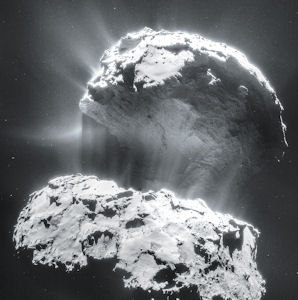
The new paper considers whether some of the variation in cometary D/H
ratio values is down to how much of a comet's surface is active.
Some of the ejected water in so-called 'hyperactive comets' has been
found to be tied up in ejected dust grains from the comet, which then
release the additional water into the coma by sublimation. Because
these hydrated dust grains seem to preferentially combine with
deuterated water, active comets ejecting the grains into space exhibit
high relative abundances of deuterated water. As a result, a
correlation emerges between hyperactive comets and terrestrial water
values. Other less-active comets do not seem to undergo this
fractionation of water in quite the same way, likely because of a lack
of water ice on or near their surfaces.
If this finding could be extended broadly amongst comets (and there are
plenty of reasons why it might not!) then the explanation for the origin
of terrestrial water may swing back towards comet deposition through
collision. The location where comets form is crucial here.
If they form beyond the 'snowline' in the solar system, then their water
content is explainable, and a trend towards higher deuteration could
build as the distance of formation extends outwards. Again, this
is complicated by the potential for many bodies in the solar system to
migrate about and change their locations over time.
I've often argued that the Earth's initial position could have been
further out than it currently is, to a location beyond the 'snowline'
>3AU from the Sun. Such a possibility has one major advantage over the
assumption that the Earth formed in its current location: it would
readily explain the presence of its water. I recently put this to
leading astrophysicists Michele Bannister, who replied with the
following point:
"The problem
is not so much migrating Earth as getting it to survive
Jupiter migrating, particularly if the grand tack was
indeed an event. So it doesn't tend to get moved more
than a bit of an AU. Inner solar system has a lot less
room to play with." (2)
I'll be honest - I have a different
basis for how Earth got shunted into the inner solar
system... but then that's all very speculative. I
think there's some flexibility built into this, because
the theoretical models generally assume that only the
current set of planets are players in the early solar
system, with Jupiter and Saturn (and to some extent
Neptune) being major players in any major migratory
events. The Nice model (incorporating the 'grand
tack' Michele mentions) may be the generally accepted
model (and does, to be fair, explain a fair old bit),
but there remain other tantalising possibilities, too.
Shunt the Earth out a bit at the beginning, and
terrestrial water become a lot less of a puzzle.
Written by Andy Lloyd,
24th April
2019
References:
1) D. Lis et al "Terrestrial
deuterium-to-hydrogen ratio in water in hyperactive comets" 19 April
2019
hal.inria.fr/hal-02361289/
2) Correspondence from Michele Bannister
replying to @darkstarandy,
23 April 2019
Previous Blog
Next Blog

Dark Star Blog Index

Dark Star
Books Index

You
can keep informed of updates
by following me on Twitter:
www.twitter.com/#darkstarandy

Or like my Facebook Page:
https://www.facebook.com/darkstarandylloyd













